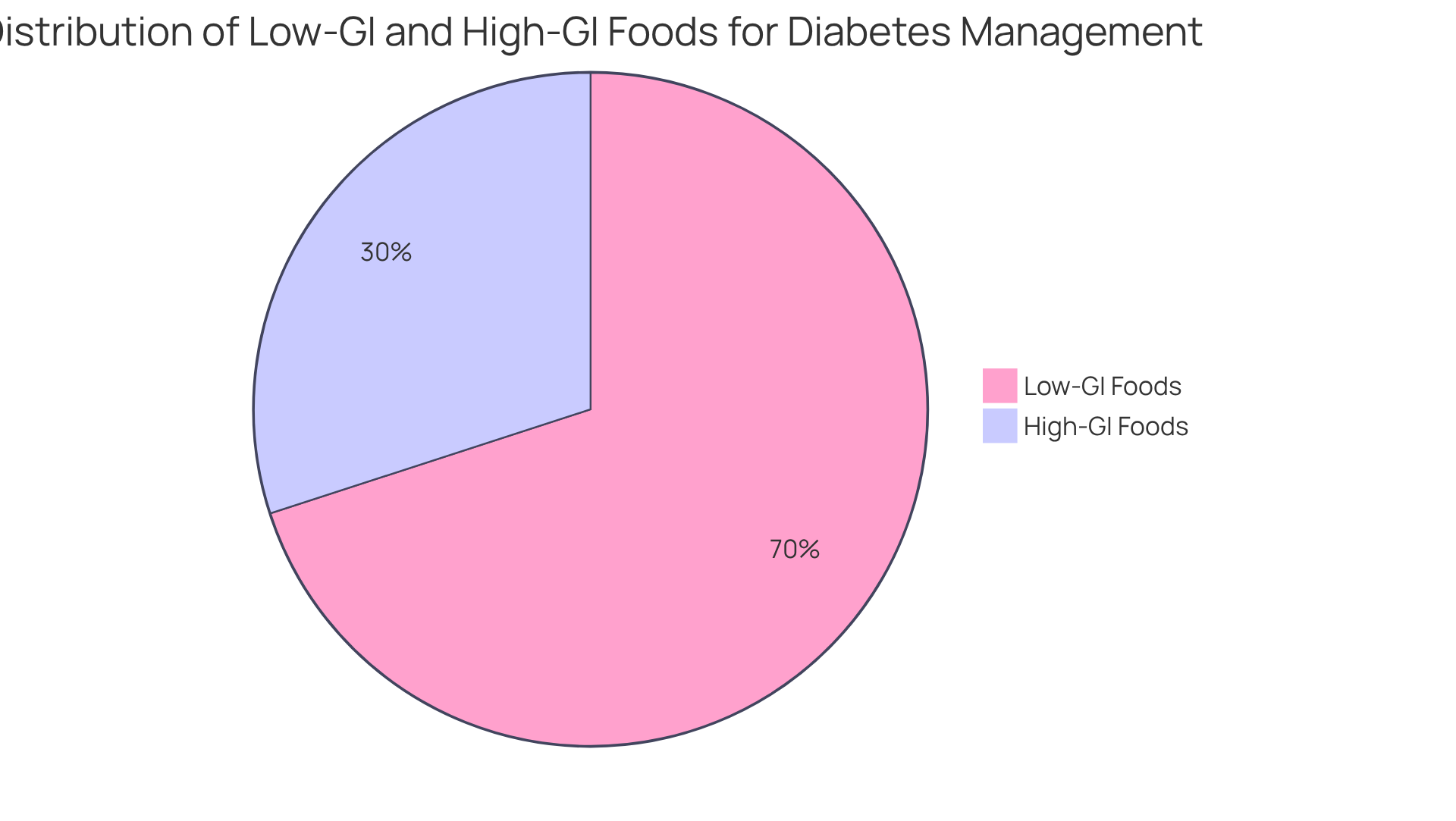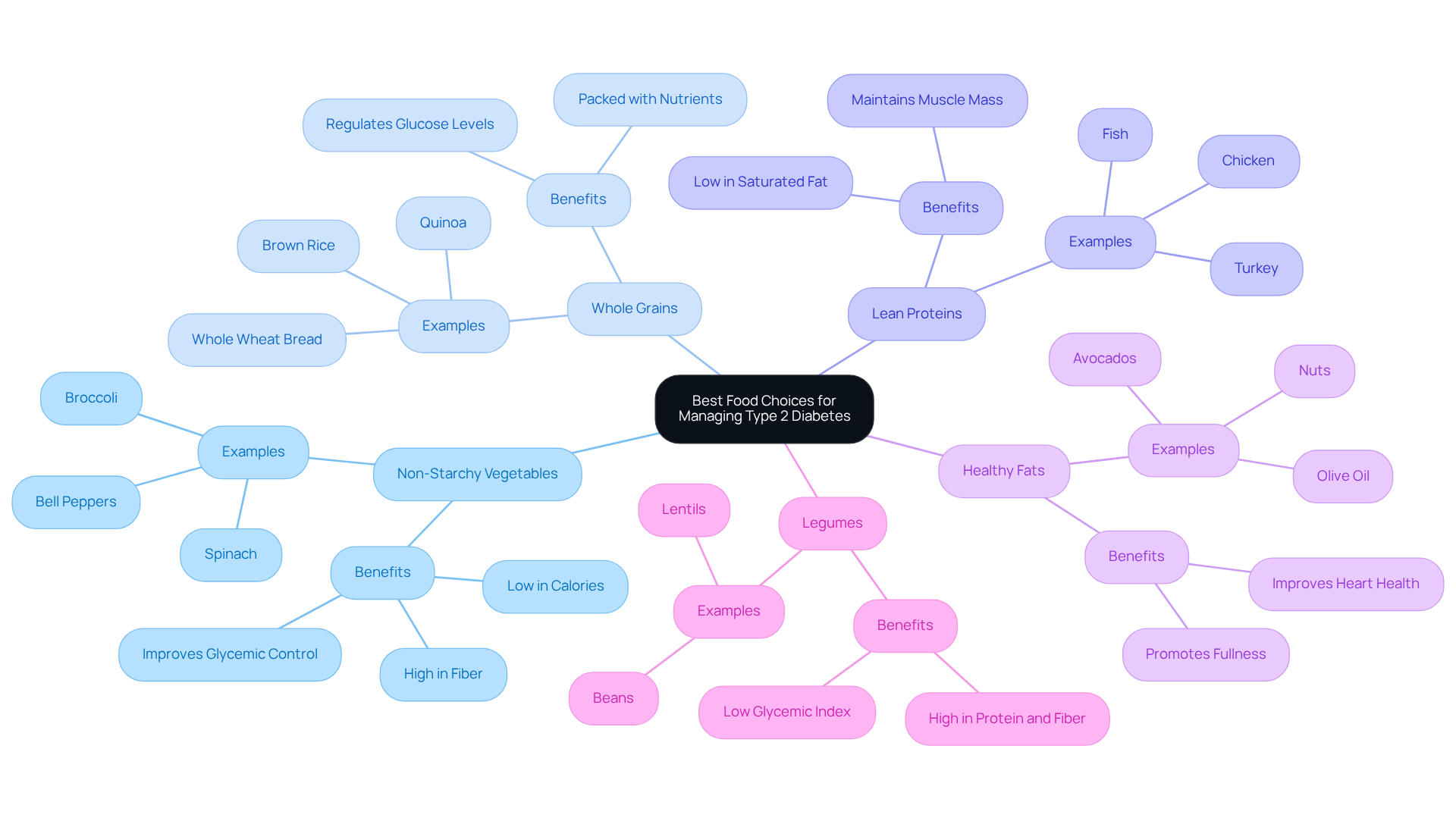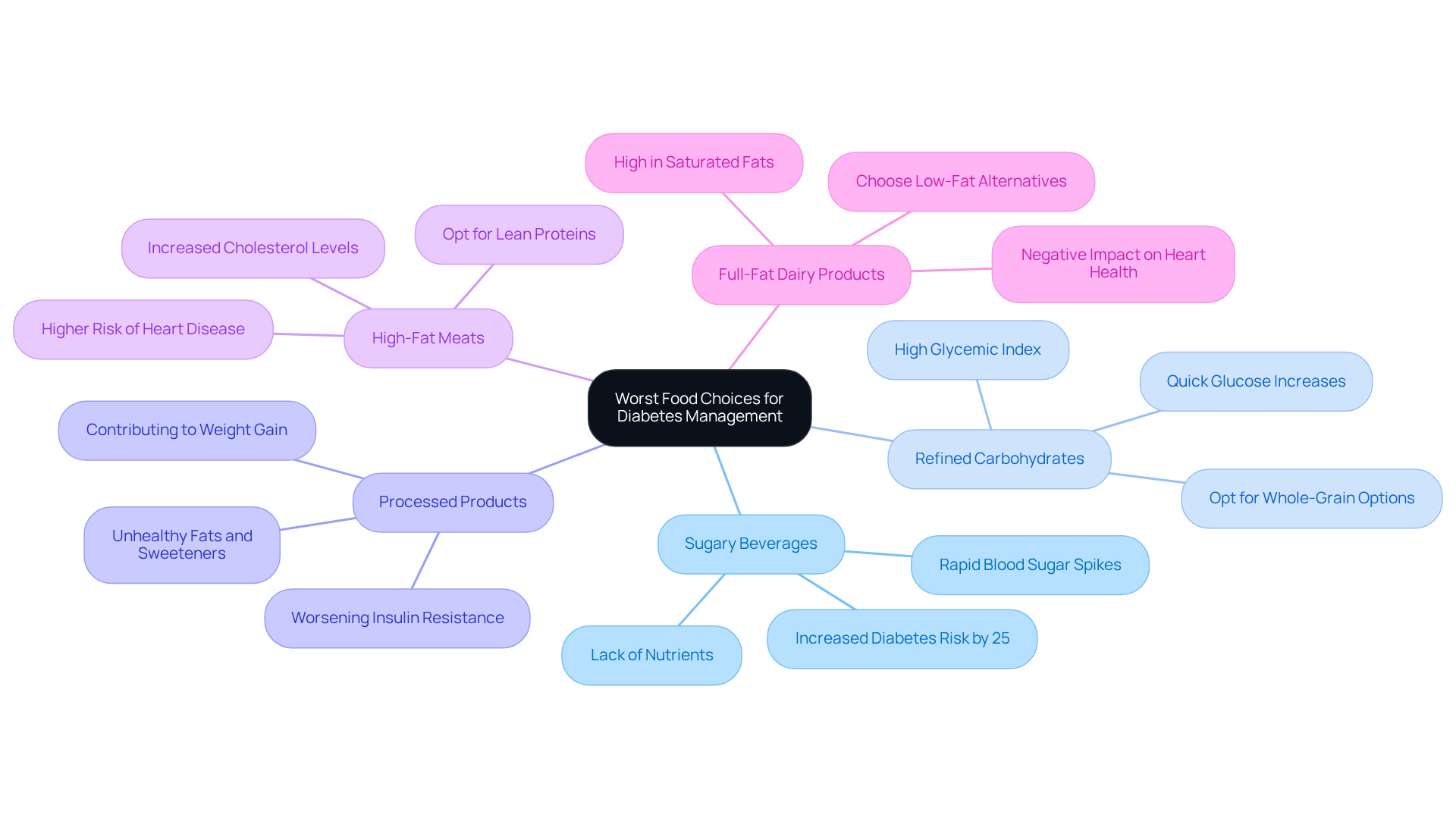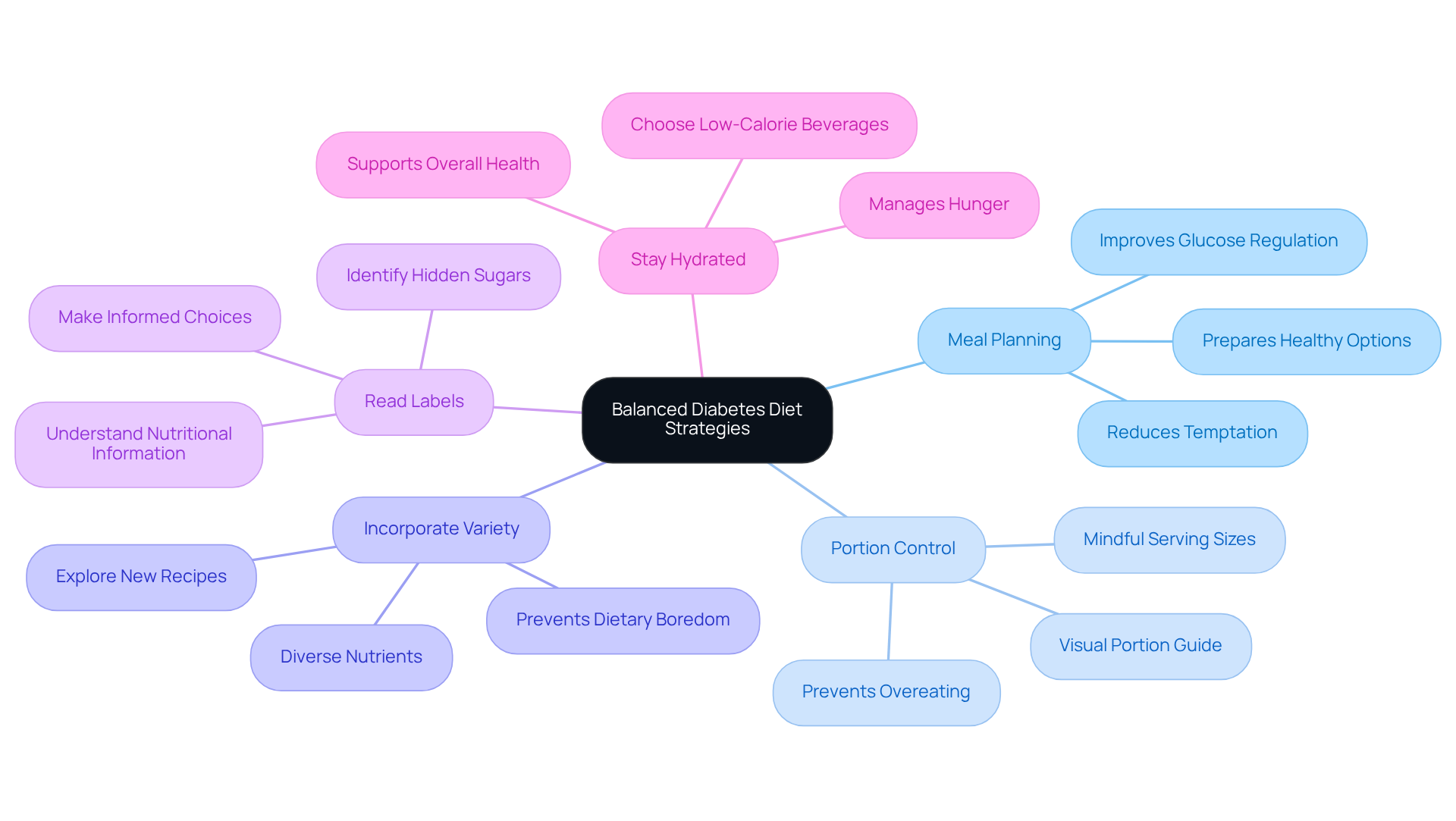Overview
Managing Type 2 diabetes can feel overwhelming, but making the right food choices can significantly help. Non-starchy vegetables, whole grains, lean proteins, healthy fats, and legumes are excellent options. These foods not only help regulate blood sugar levels but also provide essential nutrients that your body needs. It's comforting to know that these foods have low glycemic indices, which means they have a gentle impact on your blood sugar, unlike high-GI foods and sugary beverages that can cause rapid spikes.
Understanding what to eat is just one part of your journey. You’re not alone in this; many have faced similar challenges and found success in making these dietary changes. By choosing foods that support your health, you can take meaningful steps toward better glucose control. Remember, it’s important to seek support and explore resources that can guide you on this path. Together, we can navigate this journey toward a healthier you.
Introduction
Understanding the intricate relationship between food choices and Type 2 diabetes management is essential for maintaining optimal health. It's understandable to feel overwhelmed by the complexities of dietary options. With the right knowledge, you can navigate these choices and make informed decisions that positively impact your blood sugar levels.
However, discerning which foods truly support diabetes management can be challenging. What if the key to better health is as simple as knowing the best and worst foods for diabetes? You're not alone in this journey, and we are here to support you every step of the way. Together, we can explore how to make choices that nourish your body and help you thrive.
Understanding Food Choices for Type 2 Diabetes Management
At T2DSolutions, we are genuinely excited to introduce ourselves as your new resource hub, dedicated to providing education and community support for managing Type 2 and Type 3 diabetes. We understand that managing Type 2 diabetes can feel overwhelming, and it requires a comprehensive understanding of diabetes type 2 food options.
It's important to recognize that foods can be classified according to their glycemic index (GI), which assesses how quickly they elevate glucose levels. Low-GI items, such as whole grains, legumes, and non-starchy vegetables, are typically recommended as diabetes type 2 food because they lead to gradual increases in glucose levels. On the other hand, high-GI items like white bread and sweet treats can cause rapid spikes in glucose, making it more challenging to manage diabetes type 2 food.
Understanding these differences is crucial for anyone aiming to maintain stable glucose levels and overall well-being. Remember, you're not alone in this journey; we're here to support you every step of the way. If you have questions or need guidance, please reach out to our community for the resources you need.

Best Food Choices: Nutritional Benefits and Impact on Blood Sugar
When it comes to managing Type 2 Diabetes, making thoughtful food choices can significantly impact your health and well-being. At T2DSolutions, we understand the challenges you may face, and we are here to provide valuable resources and support as you navigate your journey toward better diabetes management. Subscribe to stay updated on new content and insights that can help you along the way!
-
Non-Starchy Vegetables: Incorporating vegetables like spinach, broccoli, and bell peppers into your meals can be a game changer. These options are low in calories yet high in fiber, which is essential for keeping your glucose levels stable. Research shows that increasing your vegetable intake can greatly improve glycemic control, with many individuals experiencing significant decreases in HbA1C values during interventions.
-
Whole Grains: Whole grains such as quinoa, brown rice, and whole wheat bread are vital additions to your diet. Packed with fiber and nutrients, they help regulate glucose levels effectively. Studies suggest that consuming over 150 grams of whole grains daily can lead to better glycemic responses and lower fasting glucose readings.
-
Lean Proteins: Foods like chicken, turkey, and fish are excellent for maintaining your muscle mass while keeping saturated fat intake low. Nutritionists emphasize the importance of lean proteins in a diabetes-friendly meal plan, as they help you feel full and assist in managing glucose levels.
-
Healthy Fats: Don't forget about healthy fats! Including sources such as avocados, nuts, and olive oil can improve heart health and promote feelings of fullness, helping to prevent overeating. These fats are essential for a balanced diet and can support your metabolic health.
-
Legumes: Beans and lentils are fantastic choices, offering both protein and fiber. Their low glycemic index makes them perfect for keeping your blood sugar stable, and they can be easily added to various meals.
By incorporating these nutrient-dense selections into your daily meals, you not only enhance your nutritional intake but also play a crucial role in managing your diabetes effectively. For example, imagine enjoying a salad filled with non-starchy vegetables, topped with grilled chicken and a drizzle of olive oil. This can be a satisfying and healthful meal option that nourishes your body. Remember, focusing on these nutrient-rich foods can lead to significant progress in your diabetes management journey. You're not alone in this journey, and we are here to support you every step of the way.

Worst Food Choices: Risks and Consequences for Diabetes Management
Managing Type 2 Diabetes can feel overwhelming, especially when it comes to making choices about diabetes type 2 food. Certain diabetes type 2 food options pose considerable risks and should be approached with caution to help maintain stable blood sugar levels and reduce the risk of complications. Here are some key items to be mindful of:
-
Sugary Beverages: Drinks like soda and sweetened juices can cause rapid spikes in blood sugar. Research shows that for each additional 12-ounce serving of sugar-sweetened beverages consumed daily, the risk of developing Type 2 diabetes increases by 25 percent. These drinks not only contribute to weight gain but also lack essential nutrients, making them particularly harmful.
-
Refined Carbohydrates: Foods such as white bread, pastries, and sugary cereals rank high on the glycemic index, leading to quick increases in glucose levels. It's understandable to enjoy these foods, but opting for whole-grain options can greatly influence glucose management, which is essential for diabetes type 2 food choices.
-
Processed Products: Items like chips, cookies, and quick meals are often packed with unhealthy fats and sweeteners, worsening insulin resistance. These can lead to weight gain and heightened glucose concentrations, complicating diabetes control further.
-
High-Fat Meats: Fatty cuts of beef, pork, and processed meats can raise cholesterol levels and increase the risk of heart disease, a concern for individuals with diabetes. Choosing leaner protein sources is a wise decision to help mitigate these risks.
-
Full-Fat Dairy Products: These products are typically high in saturated fats, which can negatively affect cardiovascular health. Opting for low-fat dairy alternatives can support both diabetes management and heart health.
Steering clear of these dietary options is crucial for effective management of diabetes type 2 food. Remember, you’re not alone in this journey. By making informed choices, you can take steps toward a healthier future. If you’re feeling uncertain, seeking support from healthcare professionals can provide guidance tailored to your needs.

Making Informed Choices: Strategies for a Balanced Diabetes Diet
Creating a balanced diet that incorporates diabetes type 2 food for managing Type 2 Diabetes can feel overwhelming, but you’re not alone in this journey. Here are some nurturing strategies to help you take control of your health:
-
Plan Meals Ahead: Preparing meals in advance not only ensures that healthy options are readily available but also reduces the temptation to choose less nutritious foods. Studies show that individuals who engage in meal planning tend to follow dietary guidelines more closely, leading to improved glucose regulation. T2DSolutions offers meal planning guides to assist you in this process, making it easier to stay on track.
-
Portion Control: Being mindful of portion sizes is crucial in preventing overeating and maintaining a healthy weight. Research indicates that even low glycemic index foods can raise blood sugar levels if consumed in large amounts. T2DSolutions provides a handy portion guide to help you visualize appropriate serving sizes, empowering you to make informed choices.
-
Incorporate Variety: A diverse diet not only supplies essential nutrients but also helps prevent dietary boredom. By including a variety of diabetes type 2 food—such as non-starchy vegetables, lean proteins, and whole grains—you can enhance satisfaction and adherence to dietary guidelines. T2DSolutions encourages you to explore new recipes and meal combinations to keep your dining experience exciting and enjoyable.
-
Read Labels: Understanding product labels is essential for identifying hidden sugars and unhealthy fats. This knowledge empowers you to make informed decisions, as many packaged items contain added sugars that can spike blood glucose levels. T2DSolutions will provide resources to help you decode food labels effectively, ensuring you feel confident in your choices.
-
Stay Hydrated: Remember, drinking plenty of water is vital for managing hunger and supporting overall health. Choosing water or low-calorie beverages can help you stay hydrated without adding unnecessary calories.
By implementing these strategies and utilizing the resources offered by T2DSolutions, you can take charge of your dietary choices, leading to better management of diabetes type 2 food. Additionally, connecting with community support through T2DSolutions can foster resilience and improve adherence to dietary guidelines. Sharing experiences often enhances motivation and commitment to healthy eating, reminding you that you are not alone on this journey.

Conclusion
Understanding the right food choices is essential for effectively managing Type 2 Diabetes. It's important to know that a well-planned diet can significantly influence your blood sugar levels and overall health. By focusing on low-glycemic index foods, such as non-starchy vegetables, whole grains, lean proteins, and healthy fats, you can create a balanced meal plan that supports your diabetes management journey. Conversely, avoiding high-glycemic index items, including sugary beverages and refined carbohydrates, is crucial to prevent blood sugar spikes.
Key insights highlight the importance of:
- Meal planning
- Portion control
- Incorporating a variety of foods to enhance your nutritional intake while keeping meals enjoyable
It’s also vital to understand food labels and stay hydrated, as these strategies empower you to make informed dietary choices. These practices not only help in maintaining stable glucose levels but also promote a healthier lifestyle overall.
Ultimately, the significance of food choices in managing Type 2 Diabetes cannot be overstated. By adopting these strategies and utilizing available resources, you can take proactive steps toward better health. Connecting with supportive communities can further enhance your motivation and adherence to dietary guidelines. Remember, you're not alone in this journey; embracing it with knowledge and support can lead to improved well-being and a brighter future for those managing diabetes.
Frequently Asked Questions
What is the purpose of T2DSolutions?
T2DSolutions serves as a resource hub dedicated to providing education and community support for managing Type 2 and Type 3 diabetes.
Why is understanding food choices important for managing Type 2 diabetes?
Understanding food choices is crucial for managing Type 2 diabetes as it helps individuals maintain stable glucose levels and overall well-being.
How are foods classified in relation to diabetes management?
Foods are classified according to their glycemic index (GI), which measures how quickly they elevate glucose levels in the body.
What types of foods are recommended for Type 2 diabetes management?
Low-GI foods such as whole grains, legumes, and non-starchy vegetables are recommended as they lead to gradual increases in glucose levels.
What types of foods should be avoided for Type 2 diabetes management?
High-GI foods like white bread and sweet treats should be avoided as they can cause rapid spikes in glucose levels, making diabetes management more challenging.
How can individuals get support while managing Type 2 diabetes?
Individuals can reach out to the T2DSolutions community for questions, guidance, and resources to support them in their diabetes management journey.



